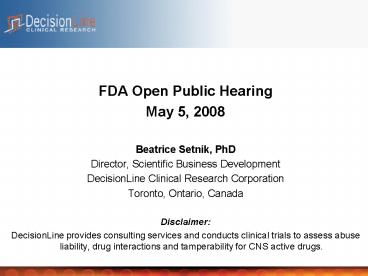FDA Open Public Hearing - PowerPoint PPT Presentation
1 / 5
Title:
FDA Open Public Hearing
Description:
DecisionLine provides consulting services and conducts clinical trials to assess ... But in order to be effective, cannot be easily defeated. Summary ... – PowerPoint PPT presentation
Number of Views:34
Avg rating:3.0/5.0
Title: FDA Open Public Hearing
1
- FDA Open Public Hearing
- May 5, 2008
- Beatrice Setnik, PhD
- Director, Scientific Business Development
- DecisionLine Clinical Research Corporation
- Toronto, Ontario, Canada
- Disclaimer
- DecisionLine provides consulting services and
conducts clinical trials to assess abuse
liability, drug interactions and tamperability
for CNS active drugs.
2
Alcohol and Dose Dumping
- The term dose dumping is frequently used and
often indiscriminately - Describes accelerated drug release from modified
release formulations (MRF) - The term is non-quantitative and implies actual
clinical importance - Based historically on PK data for most CNS drugs
PK is highly variable and there is a poor
correlation of PK and PD - Pharmacokinetic (PK) data do not predict
- Safety individual or risk to groups of patients
- Pharmacodynamic effects e.g. motor or cognitive
impairment - Efficacy
- Naltrexone cover often used with opioids (e.g.
Palladone study) - Statistically significant increase in mean plasma
morphine levels (AUC0-24 ? 23 Cmax ?14.5)
resulting from co-administration of morphine (60
mg) naltrexone (300 mg) (Bashaw et al., 1995) - Prevents gathering data on safety and PD data
- The clinical importance can only be determined if
pharmacodynamic and safety measures are included - Relevance to patient populations and drug abusers
3
Correlation of In Vitro and Clinical Data
Alcohol effects
- In vitro data not always correlated to clinical
data - e.g. OPANA ER
- In vitro data showed that oxymorphone was not
released more rapidly in 500 mL of 0.1N HCl
solutions containing ethanol (4, 20, and 40) - Clinical data combining 40 mg OPANA ER and
alcohol (4, 20 and 40) in healthy, fasted
volunteers showed that with 40 ethanol - Mean AUC (oxymorphone) was 13 higher (not
statistically significant) - Cmax was highly variable, increased on average by
70 and up to 270 in individual subjects - In vitro studies
- Inexpensive, quick
- Provide data on physical/chemical properties of
formulation - However, clinical studies
- Provide valuable information on pharmacokinetics
and pharmacodynamic effects when various doses of
alcohol are administered at various time, in
relation to drug administration
4
Terminology
- Abuse deterrent and tamper resistant are
often interchanged they are not equivalent. - Tamper Resistant formulations can either
- Contain a controlled release caption that is not
easily accessible - Difficult to crush/chew/grind/dissolve
- Or when tampered with have physical/chemical
properties that are not appealing for
administration - Prevention of snorting, injection, smoking, oral
administration - Addition of aversive/blocking agents (e.g.
capsaicin) - However, may contain an IR caption that may be
abused when intact - Abuse Deterrent formulations
- Means the formulation is designed without
tampering to be less attractive for non-medicinal
use, e.g. by decreasing the peak high, delaying
the time of the peak effects or the rate of onset
of effects or decreasing the overall effects
(AUC) - But in order to be effective, cannot be easily
defeated
5
Summary
- Experimental human studies and epidemiologic
safety data are needed to address the clinical
relevance of drug/alcohol interactions and dose
dumping. - Determination of clinical importance requires the
inclusion of sensitive clinical measures of
safety and pharmacodynamic endpoints in
pharmacokinetic studies - Dose dumping should only be used to describe
situations where tampering results in a
clinically important consequence - Criteria for clinical importance should be
developed for target drug classes - Appropriate terminology and evidence is required
to describe new formulation technologies designed
to reduce tampering and abuse potential.































